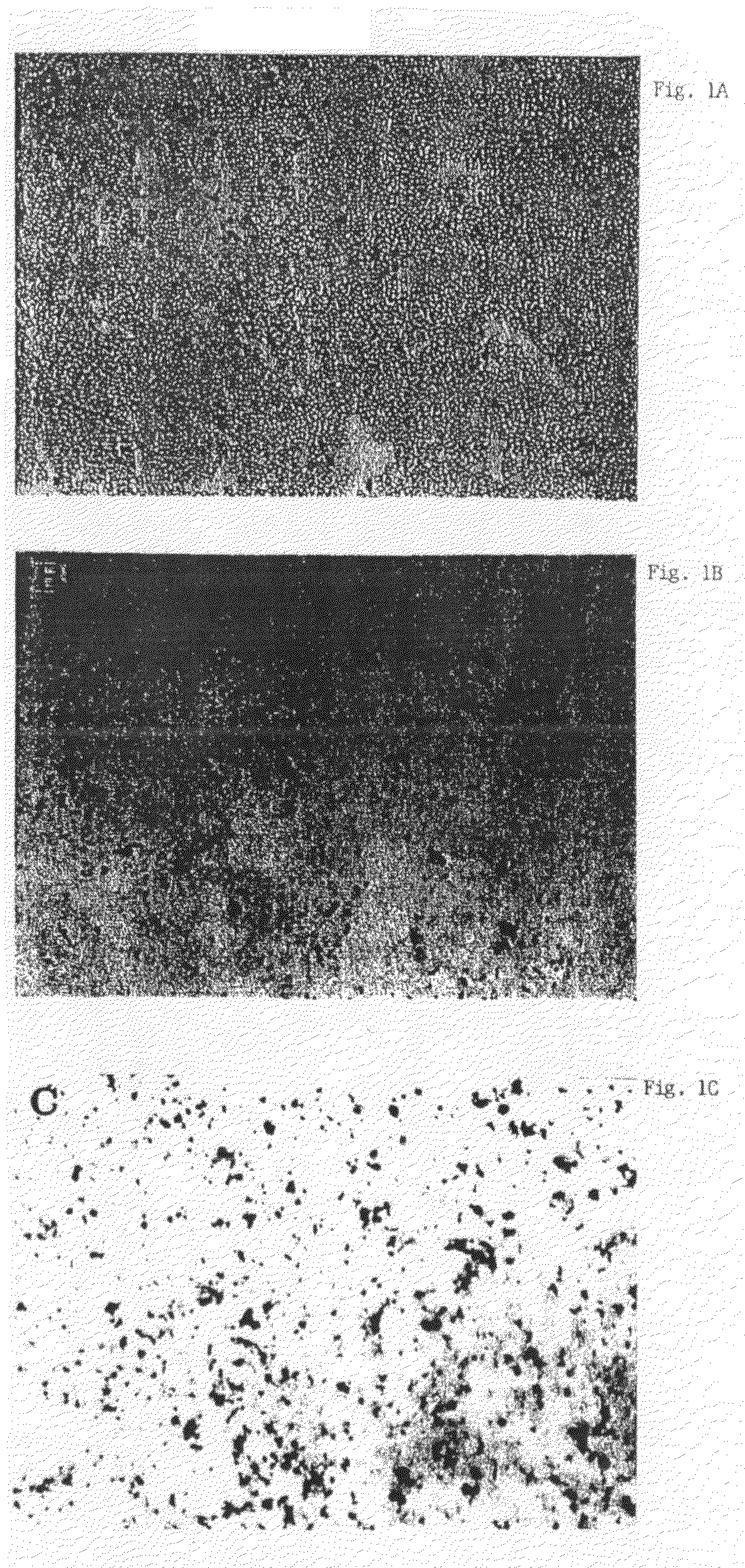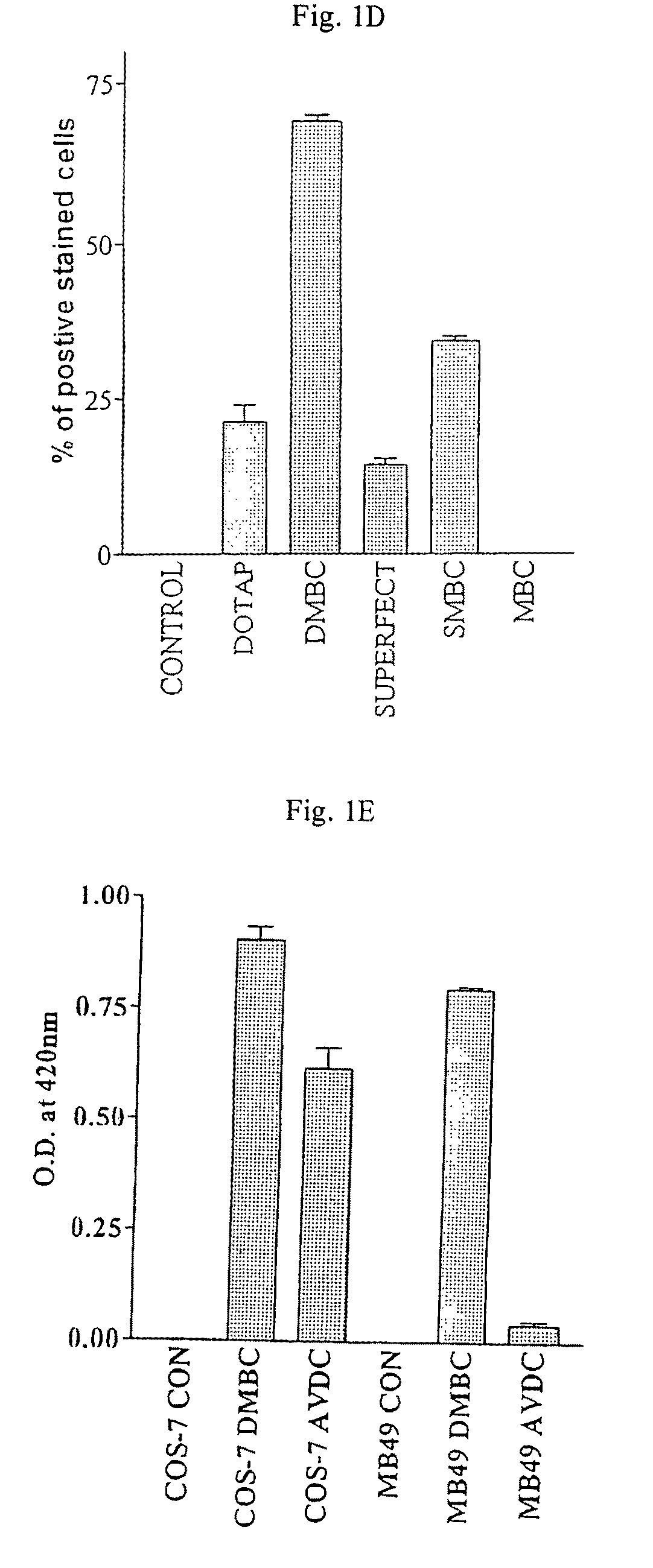Methods and compositions for delivery of pharmaceutical agents
a technology of pharmaceutical agents and compositions, applied in the direction of botany apparatus and processes, pharmaceutical non-active ingredients, immunoassays, etc., can solve the problems of inability to achieve effective therapeutic delivery of genes into various cell types, in particular in vivo delivery, and the inability to efficiently deliver as well as other therapeutic molecules, to achieve the effect of delivering therapeutically sufficient amounts of genes
- Summary
- Abstract
- Description
- Claims
- Application Information
AI Technical Summary
Benefits of technology
Problems solved by technology
Method used
Image
Examples
example 1
In Vitro Transfection Efficiency of Non-Viral Agents
[0114]The pCMVlacZ expression plasmid was used to assess the transfection efficiency of various non-viral agents, in a 2 hour time period, on MB49 cells. Both DOTAP and Superfect were able to transfect MB49 cells within a 2 h time period with efficiencies of approximately 20.4% and 14.8% respectively (see Table 1 below).
[0115]
TABLE 1TransfectionNon-viral agentTypeefficiencyDOTAPCationic Lipid20.4%SuperfectDendrimer14.8%FugeneNon-liposomal1.02%Calcium chlorideChemical0%DEAE-DextranChemical0%
[0116]Transfection conditions were optimized for each agent, to ensure maximum transfection at 2 h. Transfection efficiency was measured by counting the percentage of cells stained blue with X-gal. Optimal transfection was obtained using 7.5 μg of DNA and 20 μg DOTAP. With Superfect, a much lower amount of DNA was needed to obtain similar transfection rates as DOTAP namely 2 μg DNA with 7.5 μl of Superfect. A very low transfection rate of 1.02% w...
example 2
Duration of β-Galactosidase Gene Expression
[0118]Characterization of β-galactosidase (β-gal) gene expression as a function of time following transfection with DMBC was done. As shown in FIG. 2A, protein expression, as determined by the ONPG assay, occurred within 1 h of the removal of the agent and increased up to 48 h post transfection. After 48 h, there was a steady decrease in protein expression and by 12 days post-transfection, the β-gal activity had decreased by 7 fold compared to the expression at day 2 (FIG. 2B). It appears that as the cells replicate, the gene is lost and / or silenced.
example 3
DNA Uptake Following Transfection
[0119]In order to determine whether there was a difference in DNA uptake when using DOTAP and DMBC, the quantity of plasmid DNA extracted from cells was measured 2 h after transfection. To minimize the amount of surface bound DNA and get a better estimate of true DNA uptake; multiple washes were performed with 1×PBS as well as digestion with DNAse. FIGS. 3A and 3B show the PCR analysis of DNA extracted from MB49 cells. MB49 cells seem to have internalized similar amounts of plasmid DNA with both agents. Therefore, the differences observed in transfection efficiencies are not due to the differential uptake of plasmid DNA but perhaps to the stability of the DNA once taken into cells.
PUM
 Login to View More
Login to View More Abstract
Description
Claims
Application Information
 Login to View More
Login to View More - R&D
- Intellectual Property
- Life Sciences
- Materials
- Tech Scout
- Unparalleled Data Quality
- Higher Quality Content
- 60% Fewer Hallucinations
Browse by: Latest US Patents, China's latest patents, Technical Efficacy Thesaurus, Application Domain, Technology Topic, Popular Technical Reports.
© 2025 PatSnap. All rights reserved.Legal|Privacy policy|Modern Slavery Act Transparency Statement|Sitemap|About US| Contact US: help@patsnap.com



